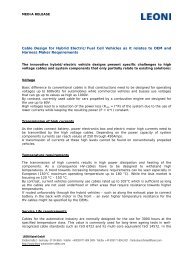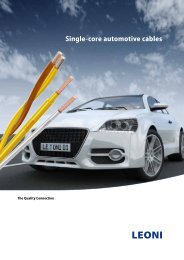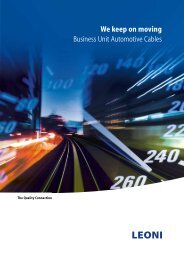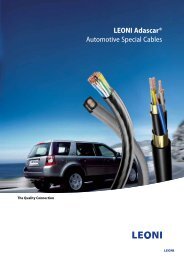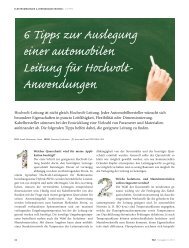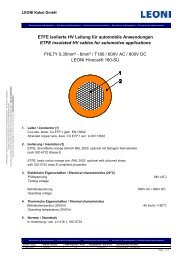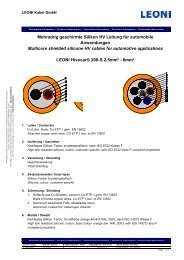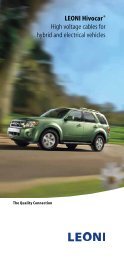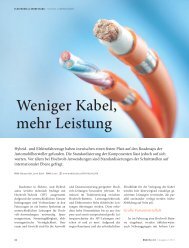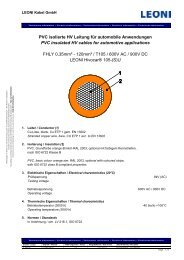LEONI inTEAM 2/2007 - LEONI Business Unit Automotive Cables
LEONI inTEAM 2/2007 - LEONI Business Unit Automotive Cables
LEONI inTEAM 2/2007 - LEONI Business Unit Automotive Cables
Sie wollen auch ein ePaper? Erhöhen Sie die Reichweite Ihrer Titel.
YUMPU macht aus Druck-PDFs automatisch weboptimierte ePaper, die Google liebt.
Ausgabe Issue 2 / <strong>2007</strong><br />
<strong>inTEAM</strong><br />
Kundenmagazin der Strategic <strong>Business</strong> <strong>Unit</strong> <strong>Automotive</strong> & Standard <strong>Cables</strong><br />
Customer magazine of Strategic <strong>Business</strong> <strong>Unit</strong> <strong>Automotive</strong> & Standard <strong>Cables</strong><br />
Skinschicht für optimalen Haftsitz Skin layer for optimum adherence<br />
<strong>LEONI</strong> Adascar ® – Safe in every sense <strong>LEONI</strong> Adascar ® – Safe in every sense<br />
<strong>LEONI</strong> exFC® – Partnerschaft mit Dräxlmaier <strong>LEONI</strong> exFC® – Partnership with Dräxlmaier
Inhalt Content<br />
AEShow <strong>2007</strong> in Shanghai 3<br />
Skinschicht für optimalen Haftsitz 4<br />
<strong>LEONI</strong> Adascar ® – Safe in every sense 6<br />
Neue Chemikaliengesetzgebung<br />
REACH tritt in Kraft 8<br />
Erfolg durch klare Strukturen 10<br />
Effi zienzplus durch Einsatz von Advaris C2 11<br />
Dokumentation der ökologischen Verantwortung 12<br />
<strong>LEONI</strong> exFC® – Partnerschaft mit Dräxlmaier 13<br />
<strong>LEONI</strong> startet Vertriebskooperation in Indien 14<br />
Kapazitätserweiterung in Ungarn 15<br />
Werkstoffl exikon A – Z 16<br />
Impressum / Imprint<br />
<strong>LEONI</strong> inTeam ist ein Magazin für Kunden<br />
der Strategic <strong>Business</strong> <strong>Unit</strong> „<strong>Automotive</strong> & Standard <strong>Cables</strong>“<br />
Herausgeber / Publisher:<br />
<strong>LEONI</strong> Kabel GmbH, Roth<br />
Redaktion / Editors:<br />
Claudia Schertel, Sabine Kerschbaum<br />
Technische Änderungen behalten wir uns vor.<br />
Subject to technical changes.<br />
AEShow <strong>2007</strong> in Shanghai 3<br />
Skin layer for optimum adherence 5<br />
<strong>LEONI</strong> Adascar ® – Safe in every sense 7<br />
New REACH chemicals legislation<br />
comes into force 9<br />
Success with clear structures 10<br />
Effi ciency gain from using Advaris C2 11<br />
Documentation on ecological responsibility 12<br />
<strong>LEONI</strong> exFC® – Partnership with Dräxlmaier 13<br />
<strong>LEONI</strong> launches joint sales venture in India 14<br />
Capacity expansion in Hungary 15<br />
Material dictionary A – Z 16<br />
<strong>LEONI</strong> inTeam is a magazine for customers<br />
of the “<strong>Automotive</strong> & Standard <strong>Cables</strong>” strategic business unit<br />
Anschrift / Address:<br />
<strong>LEONI</strong> Kabel GmbH<br />
<strong>Automotive</strong> & Standard <strong>Cables</strong><br />
D-91154 Roth, Stieberstraße 5<br />
Telefon +49 (0) 9171-804-2218<br />
Telefax +49 (0) 9171-804-2232<br />
E-Mail cable-info@leoni.com<br />
www.leoni-automotive-cables.com<br />
www.leoni-cable.com
AEShow <strong>2007</strong> in Shanghai<br />
Bereits zum dritten Mal öffnete die jährlich in China stattfi ndende<br />
International <strong>Automotive</strong> Electronics Products & Technologies<br />
Show and Auto + IT Summit – kurz AEShow – ihre Pforten.<br />
In diesem Jahr fand die Branchenmesse vom 25. bis 27. April im<br />
International Convention Center von Shanghai, im Wirtschaftsund<br />
High-Tech-Viertel Pudong statt.<br />
Ein Großteil der Aussteller waren führende Automobil-Hardwaresowie<br />
Software-Lieferanten.<br />
Mit dem Ziel ein weiteres neues Marktsegment anzugehen und das<br />
Unternehmen in den verschiedensten Sparten der Automobilindustrie<br />
bekannt zu machen, stellte <strong>LEONI</strong> ebenfalls auf der AEShow aus.<br />
Das Hauptinteresse der Besucher galt dabei den ABS/ESP-Sensorleitungen,<br />
Bus-Datenleitungen und Datenübertragungsleitungen sowie<br />
Hybrid-Batterieleitungen. Das chinesische Vertriebsteam erhielt wertvolle<br />
Unterstützung durch Kollegen aus dem Produktmanagement des<br />
Competence Centers Roth. „Die Messe war eine rundum gelungene<br />
Veranstaltung, wir konnten viele neue Kontakte knüpfen“, resümiert<br />
Adam Chen, Vertriebsleiter bei <strong>LEONI</strong> Cable Changzhou.<br />
AEShow <strong>2007</strong> in Shanghai<br />
For the third time already, the annual International <strong>Automotive</strong><br />
Electronics Products & Technologies Show and Auto + IT Summit<br />
– AEShow for short – in China opened its doors recently. This year<br />
the industry fair was held from 25 to 27 April at the International<br />
Convention Center in Shanghai’s commercial and high-tech district<br />
of Pudong.<br />
The majority of exhibitors were leading suppliers of automotive hardware<br />
and software.<br />
<strong>LEONI</strong> also exhibited at the AEShow with the aim of addressing another<br />
new market segment and making its name known in a wide range of different<br />
areas of the automotive industry. Visitors’ interest was directed<br />
mainly at our ABS/ESP sensor cables, bus data cables and data transmission<br />
cables as well as hybrid battery cables. Our Chinese sales team<br />
received valuable support from product management colleagues based<br />
at our Competence Center in Roth. Adam Chen, Sales Manager at <strong>LEONI</strong><br />
Cable Changzhou, summed up by saying: “The fair was an all-round successful<br />
event; we established many new contacts.”<br />
von links from left: Günter König, Salina Shao, Jake Zhou, Adam Chen, Ge Chen<br />
Adam Chen Sales Manager <strong>LEONI</strong> Cable (Changzhou), China<br />
Tel. +86 519-5138-835, E-Mail adam.chen@leoni.com<br />
<strong>LEONI</strong> <strong>inTEAM</strong> 2/<strong>2007</strong> 3
Skinschicht für optimalen Haftsitz<br />
Skin<br />
Skin<br />
Ader<br />
Core<br />
Um bei mehradrigen Mantelleitungen ein Verkleben der Adern<br />
mit dem Mantelmaterial zu vermeiden, muss ein Trennmittel<br />
oder eine Trennschicht auf den Verseilverbund aufgebracht werden.<br />
Darüber hinaus ist dies erforderlich, damit ein bestimmter,<br />
meist von den Kunden definierter, Haftsitzbereich realisiert werden<br />
kann.<br />
Stand der Technik sind Trennmittel in Pulverform als Stearat vor der<br />
Mantelextrusion.<br />
Als Trennschichten sind Folien oder Vliese unter dem Mantel gängige<br />
Lösungen. Bei diesen Technologien zeigen sich jedoch folgende<br />
Nachteile:<br />
Stearate lassen sich trotz Einsatz von hochmodernen Automaten<br />
zum Teil nur ungleichmäßig aufbringen, was hohe Schwankungen<br />
beim Haftsitz (Bild 1) zur Folge haben kann. Nach dem Abziehen des<br />
Mantels können zudem Reste des Stearats auf den Adern zurückbleiben<br />
(Bild 2 und 3). Dies kann zu Verunreinigungen in den Konfektionsautomaten<br />
führen und das Umspritzen der Leitung oder die Farberkennung<br />
über Kamerasysteme erschweren.<br />
Bei der Bandierung mit Folie oder Vlies ist ein weiterer Fertigungsschritt<br />
oder der Einsatz höherwertigerer Verseilmaschinen erforderlich,<br />
was neben dem zusätzlichen Materialaufwand zu höheren Fertigungskosten<br />
führt. Außerdem muss die Folie oder das Vlies beim Konfektionieren<br />
extra geschnitten und entfernt werden.<br />
Als Alternative zu diesen bekannten Methoden hat <strong>LEONI</strong> eine Technologie<br />
aufgegriffen, die aus der Fertigung von Koaxial-Leitungen<br />
(<strong>LEONI</strong> Dacar®) bereits bekannt ist. Diese wurde entsprechend den<br />
neuen Anforderungen weiterentwickelt.<br />
4 <strong>LEONI</strong> <strong>inTEAM</strong> 2/<strong>2007</strong><br />
Mantel<br />
Sheath<br />
Bild 1 Image 1<br />
Bild 4 Image 4 Bild 5 Image 5<br />
Bild 2 Image 2 Bild 3 Image 3<br />
Auf die u.a. nach ISO 6722 ausgelegten Adern wird im Koextrusionsverfahren<br />
ein dünner Skin mit nur wenigen Mikrometern (μm=10 -3 mm)<br />
Stärke extrudiert (Bild 4). Dieser Skin verhindert beim Extrudieren des<br />
Mantels ein Verkleben mit den Adern, da hierfür ein entsprechendes<br />
Material mit anderer Polarität eingesetzt wird, zum Beispiel ein Polyolefin-Skin<br />
auf PVC-Adern.<br />
Die Prozessfähigkeit und Schichtdicke kann über eine Kapazitätsmessung<br />
im Wasserbecken (Kühlbecken) überwacht werden, da die<br />
Dielektrizitätskonstanten vom Grund- und Skinmaterial unterschiedlich<br />
sind. Ein Ansteigen der Schichtdicke würde schließlich eine merkliche<br />
Änderung der Kapazität zur Folge haben (Bild 5).<br />
Die Vorteile der trennmittelfreien Lösung zeigen sich vor allem bei<br />
der Konfektion. So sind beim Haftsitz des Mantels engere Toleranzbereiche<br />
realisierbar. Beim Abisolieren ist damit ein Nachjustieren der eingestellten<br />
Parameter seltener erforderlich. Darüber hinaus ist der Haftsitz<br />
des Mantels über die gesamte Abzugslänge gleichmäßig. Dies hat<br />
zum einen weniger Ausschuss durch prozesssichere Verarbeitbarkeit<br />
zur Folge, zum anderen entsteht geringerer Aufwand bei Reinigung<br />
und Instandhaltung der Anlagen.<br />
<strong>LEONI</strong> hat für diese Technologie ein Patent angemeldet und sieht<br />
einer Erteilung sehr positiv entgegen. Freigabeverfahren bei namhaften<br />
OEMs, wie zum Beispiel Daimler, stehen kurz vor dem Abschluss. Viele<br />
Konfektionäre haben die Vorteile dieser Technologie bereits erkannt<br />
und stellen bestehende Serienprodukte auf die trennmittelfreie Lösung<br />
um. Gerne prüfen wir die Realisierbarkeit auch bei Ihren Produkten<br />
oder erarbeiten für Ihre Anwendung eine entsprechende Lösung.
In order to avoid conductors of multi-core cables from sticking with<br />
the sheath material, a separating agent or separating layer has to<br />
be applied to the stranded cores. This is also necessary to make sure<br />
that a certain, usually customer-defined, adherence values can be<br />
produced.<br />
The technology currently being used involves a separating agent in<br />
powder form as a stearate before extruding the sheath.<br />
Standard separating layer solutions are film or mat layers under the<br />
sheath. However, the following disadvantages are readily visible when<br />
using this type of technology:<br />
Despite the use of ultra-modern automated technology, stearates can<br />
often only be applied somewhat unevenly, which can result in noticeable<br />
variations of the adherence (Image 1). After removing the sheath, it<br />
can happen that traces of the stearate remain on the conductors (Image 2<br />
and 3). This can lead to impurities when using automated assembly<br />
lines and impede injection mould around inserts or colour recognition<br />
via camera systems.<br />
When banding with film or mat layers an additional manufacturing<br />
step or the use of higher-quality stranding machinery is often necessary.<br />
This brings about higher manufacturing costs as well as extra material<br />
purchases. In addition, the foil or fleece has to be cut separately and<br />
removed during the assembly process.<br />
As an alternative to these well-known methods <strong>LEONI</strong> has adopted<br />
a technology already known from the manufacturing of coaxial cables<br />
(<strong>LEONI</strong> Dacar®). This has been continually developed according to the<br />
new requirements.<br />
Skin layer for optimum adherence<br />
On the conductors, designed in accordance with the ISO 6722 standard,<br />
among others, only a thin skin of just a few micrometers (μm = 10 -3 mm)<br />
is extruded via co-extrusion method (Image 4). On extrusion, this skin<br />
prevents the sheath from sticking to the conductors as a corresponding<br />
material with a different polarity is used, for example, a polyolefin skin<br />
on PVC fibres.<br />
The process capability and coating thickness can be monitored using<br />
the capacity gauge in the tank (cooling pond) as the dielectricity constants<br />
of the base and skin material are different. An increase in the<br />
coating thickness would make a noticeable difference to the capacity<br />
(Image 5).<br />
The advantages of the solution that does not involve separating agents<br />
can be seen most noticeably when assembling. When this method is used<br />
the adherence of the sheath makes narrower tolerance areas possible.<br />
When removing the insulation, the set parameters are not required to be<br />
readjusted as often. Furthermore, the adherence of the sheath runs evenly<br />
along the whole length of the pull-of-device. On the one hand, this means<br />
that there is less waste thanks to process-capable workability. While on<br />
the other hand, it does not take as much effort to clean and maintain the<br />
equipment as it did before.<br />
<strong>LEONI</strong> has a patent pending for this technology and is quite assured<br />
that it will be granted. Release procedures with well-known OEMs, like for<br />
example, Daimler, are soon to be completed. Many assemblers already<br />
know the benefits of using this technology and, due to that fact that it<br />
avoids the use of separating agents, they are switching their existing<br />
product series to this one. We would be glad to examine how feasible this<br />
is for your product and even work on development of the corresponding<br />
solution for your needs.<br />
Markus Heipel Product Management<br />
Tel. +49 (0)9171-804-2383, E-Mail markus.heipel@leoni.com<br />
<strong>LEONI</strong> <strong>inTEAM</strong> 2/<strong>2007</strong> 5
<strong>LEONI</strong> Adascar ® – Safe in every sense<br />
Seit mehr als 25 Jahren entwickelt und produziert <strong>LEONI</strong> Lei-<br />
tungen für die Übertragung von hochsensiblen Informationen<br />
zu den Fahrsicherheitssystemen, wie dem Antiblockiersystem<br />
(ABS) und dem Elektronischen Stabilitätsprogramm (ESP).<br />
Nun hat <strong>LEONI</strong> sein Produktspektrum bei Sensorleitungen um<br />
eine 150°C-beständige Leitung erweitert. Damit entsprach das<br />
Unternehmen der Forderung nach immer kleineren Querschnitten<br />
mit geringerem Außendurchmesser, verbunden mit höheren<br />
Einsatztemperaturen bei Drehzahlsensoren. Im gleichen Zuge<br />
wurde die bestehende <strong>LEONI</strong>-Markenfamilie um die Gruppe der<br />
Sensorleitungen ergänzt.<br />
Die neue Marke <strong>LEONI</strong> Adascar® umfasst zukünftig alle Sensorleitungen,<br />
die in Fahrsicherheitssystemen im Automobil zum Einsatz<br />
kommen. Adascar® steht dabei für „Advanced driver assistance<br />
systems“ und ist Synonym für Leitungen mit besonders hohen Anforderungen<br />
an die Zuverlässigkeit. Sie müssen öl- und kraftstoffbeständig<br />
sein, eine sehr hohe Abriebfestigkeit aufweisen, hohe Biegewechselzyklen<br />
standhalten und einen Temperaturbereich bis + 150 °C<br />
abdecken. <strong>LEONI</strong> Adascar®150 verfügt daher über eine Aderisolation<br />
aus hochtemperaturfestem Isolierwerkstoff in Kombination mit einem<br />
speziellen wärmebeständigen Polyurethan-Compound als Mantelmaterial.<br />
6 <strong>LEONI</strong> <strong>inTEAM</strong> 2/<strong>2007</strong><br />
<strong>LEONI</strong> Adascar® beinhaltet auch weiterhin die qualitativ hochwertigen<br />
Sensorleitungen für bekannte Systeme wie<br />
- ABS (Antiblockiersystem)<br />
- ESP (Elektronisches Stabilitätsprogramm)<br />
- ABC (Active Body Control)<br />
- BVA (Bremsverschleißanzeige)<br />
- ALWR (Automatische Leuchtweitenregulierung).<br />
Aus den neuen Bezeichnungen sind nach wie vor die wichtigsten<br />
Informationen, wie Isolierwerkstoffe, Aufbau oder Außendurchmesser<br />
ersichtlich.<br />
<strong>LEONI</strong> ist heute führender Anbieter von ABS/ESP-Sensorleitungen<br />
in Europa und Nordamerika mit Fertigungsstandorten in Deutschland,<br />
Mexiko und in Kürze auch in China. Gerne unterbreiten wir Ihnen einen<br />
Lösungsvorschlag für Ihre Anwendung.
Die Leitungen werden künftig<br />
unter folgender Nomenklatur geführt:<br />
For more than 25 years <strong>LEONI</strong> has been developing and producing<br />
cables to transmit highly sensitive information to vehicle<br />
safety systems, such as the anti-lock braking system (ABS) and<br />
the electronic stability programme (ESP). <strong>LEONI</strong> has now extended<br />
its range of sensor cable products to include a 150 °C - resistant<br />
cable. Our company thereby met the demand for ever smaller<br />
cross sections with less outer diameter combined with higher<br />
operating temperatures for use with engine speed sensors.<br />
At the same time, we enhanced the existing <strong>LEONI</strong> brand family<br />
to include the group of sensor cables.<br />
The new <strong>LEONI</strong> Adascar® brand will in future stand for all sensor<br />
cables used in driving safety systems in motor vehicles. Adascar®<br />
stands for “Advanced driver assistance systems” and is a synonym<br />
for cables that meet particularly high reliability requirements. They<br />
must be oil and fuel resistant, have very high resistance to abrasion,<br />
have a long fl ex life and cover a temperature range up to + 150 °C.<br />
<strong>LEONI</strong> Adascar®150 therefore has core insulation made of a highly<br />
temperature-resistant insulating material combined with a special<br />
heat-resistant polyurethane compound as the jacket material.<br />
<strong>LEONI</strong> Adascar ® – Safe in every sense<br />
The nomenclature for these cables<br />
will in future be as follows:<br />
<strong>LEONI</strong> Adascar® 150 2x0.5 4.3<br />
Temperaturklasse nach ISO 6722 ISO 6722 temperature category<br />
Isolationsmaterial Insulation material<br />
G = EVA X = XLPE S = TPE-S V = PVC E = ETFE A = TPE-E G = EVA X = XLPE S = TPE-S V = PVC E = ETFE A = TPE-E<br />
N = Hochtemp. Thermoplast N = high temp. thermoplastic<br />
S = Standard PU M = Blockfreies PU<br />
W = Wärmedruckbeständiges PU H = High Temp PU<br />
Mantelwerkstoff Jacket material<br />
S = standard PU M = block-free PU<br />
W = heat pressure-resistant PU H = high temp PU<br />
Aufbau (Aderanzahl, Leiterquerschnitt) Composition (number of cores, conductor cross section)<br />
Außendurchmesser nach <strong>LEONI</strong> Datenblatt Outer diameter according to <strong>LEONI</strong> data sheet<br />
Beispiel: Example:<br />
FLRN11Y 2x0,5 mm² wird zu <strong>LEONI</strong> Adascar® 150 NH 2x0.5 4.3 FLRN11Y 2x0.5 mm² becomes <strong>LEONI</strong> Adascar® 150 NH 2x0.5 4.3<br />
<strong>LEONI</strong> Adascar® continues to contain high quality sensor cables for familiar<br />
systems such as<br />
- ABS (anti-lock brake system)<br />
- ESP (electronic stability programme)<br />
- ABC (active body control)<br />
- brake wear indicator<br />
- automatic light adjustment.<br />
These new designations still provide the most important information,<br />
such as insulation materials, composition and outer diameter.<br />
<strong>LEONI</strong> is today a leading supplier of ABS/ESP sensor cables in Europe<br />
and North America with production facilities in Germany, Mexico and<br />
soon also in China. We shall be pleased to provide you with a solution<br />
proposal for your application.<br />
Günter König Product Management<br />
Tel. +49 (0)9171-804-2202, E-Mail guenter.koenig@leoni.com<br />
<strong>LEONI</strong> <strong>inTEAM</strong> 2/<strong>2007</strong> 7
Neue Chemikaliengesetzgebung REACH tritt in Kraft<br />
<strong>LEONI</strong> schon jetzt gut gerüstet<br />
Zum 1. Juni <strong>2007</strong> trat in der Europäischen Union eine neue Chemikaliengesetzgebung<br />
in Kraft und löste damit einige der zuvor<br />
geltenden Richtlinien und Verordnungen zum Umgang mit Chemikalien<br />
ab. Mit der neuen REACH Verordnung wird in der EU das<br />
Ziel verfolgt, in Zukunft einen verbesserten und vorbeugenden<br />
Gesundheits- und Umweltschutz zu ermöglichen.<br />
Vor dem Hintergrund, dass von einem Großteil der über 100000 Chemikalien,<br />
die zur Zeit als so genannte „ Altstoffe“ in der EU vermarktet<br />
werden, mögliche gefährliche Eigenschaften nur lückenhaft erforscht<br />
sind, soll dieses Ziel durch das Anmelden (Registration), Bewerten<br />
(Evaluation) und Zulassen (Authorisation) von Chemikalien (of Chemicals)<br />
erreicht werden.<br />
Nach dem Motto „no data, no market“ dürfen künftig nur noch<br />
Stoffe in Verkehr gebracht werden, zu denen ein ausreichender Datensatz<br />
vorliegt, der sich in Art und Umfang in erster Linie nach dem jeweiligen<br />
Produktionsvolumen richtet. Gefordert werden Daten für alle<br />
Stoffe, die in einer Menge ab einer Tonne pro Jahr in der EU produziert<br />
oder in die EU importiert werden. Vollständig neu geregelt wird dabei<br />
der Umgang mit Substanzen, die vor September 1981 auf den Markt<br />
gekommen sind, den so genannten Altstoffen, die auch als „phase-in-<br />
Stoffe“ bezeichnet werden.<br />
Die Neuerungen im Überblick:<br />
- Unternehmensbezogene Registrierungen unter Berücksichtigung<br />
der Verwendungszwecke<br />
- Zulassungsverfahren für Chemikalien, die besonderen Anlass zur<br />
Besorgnis geben<br />
- Erweiterung der Verantwortung für die Produktsicherheit<br />
und Bereitstellen von Informationen über Verwendungszwecke<br />
auf alle nachgeschalteten Anwender<br />
- Chemikalienrechtliche Regelung der sicheren Verwendung<br />
von Stoffen in Erzeugnissen<br />
- Umkehrung der Verantwortlichkeiten<br />
Nach dem Prinzip der Beweislastumkehr überträgt REACH die Verantwortung<br />
für die Überprüfung der Chemikaliensicherheit von den nationalen<br />
Behörden auf die Hersteller und Importeure. Sie müssen künftig<br />
überzeugend darstellen, dass ihre Produkte sicher zu handhaben sind<br />
und weder die Gesundheit der Weiterverarbeiter oder Verbraucher/innen<br />
noch die Umwelt über Gebühr belasten. Ihre Stoffi nformationen<br />
geben Hersteller und Importeure an alle Abnehmer, die nachgeschalteten<br />
Anwender, weiter.<br />
Wesentliches Merkmal der Richtlinie ist ein Informationsaustausch<br />
entlang der gesamten Lieferantenkette. Da eine Registrierung die<br />
gesamte Wertschöpfungskette und hierbei auch möglichst alle Verwendungszwecke<br />
berücksichtigen soll, haben nicht nur Lieferanten<br />
ihren Kunden Informationen zu dem jeweiligem Stoff zu vermitteln.<br />
Auch die Kunden müssen den Lieferanten die für die Registrierung<br />
benötigten Informationen (z.B. Verwendungszwecke und Expositions-<br />
8 <strong>LEONI</strong> <strong>inTEAM</strong> 2/<strong>2007</strong><br />
daten) mitteilen, damit ihre Verwendung von der Registrierung abgedeckt<br />
werden kann. Als Basis für den Informationsaustausch wird das<br />
Sicherheitsdatenblatt herangezogen.<br />
Allerdings kommen mit der Einführung von REACH große Belastungen<br />
auf die Unternehmen in Europa zu, da nicht nur die reinen<br />
Stoff- bzw. Chemikalienhersteller, sondern die gesamte Wertschöpfungskette<br />
hiervon betroffen ist. Durch die aufwändigen administrativen<br />
Prozeduren und die damit verbundenen höheren Kosten ist<br />
global gesehen mit einem Verlust an Wettbewerbsfähigkeit zu rechnen.<br />
Dabei können die direkten und indirekten Auswirkungen auf die<br />
europäischen Unternehmen bis heute noch nicht vollständig abgeschätzt<br />
werden. Aufgrund der hohen Kosten für eine Zulassung (Schätzungen<br />
gehen von Zulassungskosten von bis zu 250.000 Euro aus)<br />
ist damit zu rechnen, dass viele Produkte vom Markt verschwinden<br />
werden.<br />
Obwohl die Richtlinie bereits in Kraft getreten ist, sind viele Details<br />
sowie die praxisnahe Umsetzung der Richtlinie noch nicht eindeutig<br />
gelöst bzw. abschließend geklärt. Beispielsweise befindet sich die<br />
„Europäische Agentur für chemische Stoffe“ mit Sitz in Helsinki gerade<br />
erst im Aufbau. Diese wird zukünftig für die Registrierung und die<br />
Zulassung der Stoffe zuständig sein. Sie wird ca. 30.000 im Handel<br />
erhältliche Stoffe unternehmensbezogen erfassen müssen und bis zu<br />
1.500 besonders besorgniserregende Stoffe werden zulassungspfl ichtig.<br />
Es bleibt abzuwarten, wie die neue Behörde die hohe Menge an<br />
Daten bewältigen kann.<br />
Mit der Möglichkeit der Vorregistrierung der Stoffe wird es je nach<br />
deren Gefährlichkeit Übergangsfristen bis zum Jahre 2018 geben.<br />
<strong>LEONI</strong> hat sich bereits früh mit REACH auseinandergesetzt. Schon in<br />
der Entwurfsebene 2004 hat <strong>LEONI</strong> in Zusammenarbeit mit dem Bayerischen<br />
Staatministerium für Umwelt, Gesundheit und Verbraucherschutz<br />
Einfluss auf die Richtlinie genommen. Das Unternehmen hat<br />
alle zum jetzigen Zeitpunkt erforderlichen Schritte eingeleitet, um für<br />
die Umsetzung der Richtlinie gut gerüstet zu sein. Unter anderem ist<br />
die Einrichtung eines übergreifenden Stoffregisters ge plant, um alle<br />
eingesetzten Materialien hinsichtlich REACH-Konformität zu bewerten<br />
und bei Bedarf weitere Maßnahmen einzuleiten.<br />
Aktuell bleiben noch viele Fragen offen und es bleibt abzuwarten,<br />
wie dieses Gesetz tatsächlich in der Praxis umgesetzt werden kann.
New REACH chemicals legislation comes into force<br />
<strong>LEONI</strong> is already well prepared<br />
New chemicals legislation came into force in the European Union<br />
on 1 June <strong>2007</strong>, thereby replacing some previously applicable guidelines<br />
and directives on handling chemicals. The new directive,<br />
known as REACH, is intended now to facilitate better and pre-emptive<br />
health and environmental protection in the EU.<br />
The majority of the more than 100,000 chemicals that are currently<br />
sold in the EU as so called “existing substances” have only been patchily<br />
researched for potentially hazardous properties. This is to be addressed by<br />
Registration, Evaluation and Authorisation of Chemicals.<br />
Under the motto of “no data, no market”, it is now possible to circulate<br />
only substances for which an adequate set of data is available, and which<br />
is geared in kind and extent primarily to the respective production volume.<br />
Such data is required for all substances that are produced in the EU or are<br />
imported into the EU in quantities of at least one ton per year. The regulations<br />
con cerning substances that reached the market before September 1981,<br />
known as existing substances or also “phase-in substances” are entirely<br />
new.<br />
Overview of what’s new:<br />
- Company-related registration that takes the intended<br />
uses into account<br />
- Authorisation procedure for chemicals that give special rise<br />
for concern<br />
- Extended responsibility for product safety and provision<br />
of information about intended uses to all downstream users<br />
- Safe use of substances in products also governed<br />
by chemicals legislation<br />
- Reversal of responsibilities<br />
According to the principle of shifting the burden of proof, REACH transfers<br />
responsibility for testing the safety of chemicals from national authorities<br />
to the manufacturers and importers. They will in future have to make a<br />
convincing case that their products can be handled safely and they will<br />
not have an unduly adverse effect on the health of processing staff, consumers<br />
or the environment. Manufacturers and importers must pass all<br />
the substance information on to customers, i.e. the downstream users.<br />
A key feature of the directive is an exchange of information along the<br />
entire supply chain. As registration is supposed to cover the entire value<br />
chain and thus if possible all manner of intended uses, not only suppliers<br />
are required to convey information to their customers on the respective<br />
substance. Customer are also obliged to provide the supplier with the information<br />
required for registration (e.g. intended uses and exposure data) so<br />
that their use may be covered by the registration. The safety data sheet<br />
serves as the basis for the exchange of information.<br />
However, the introduction of REACH will impose heavy strain on businesses<br />
in Europe because it affects not only the pure substance and chemicals<br />
producers, but the entire value chain as well. The elaborate administrative<br />
procedures and the related higher costs are likely, on the global scale, to<br />
mean a loss in ability to compete. It is so far still impossible to fully estimate<br />
both the direct and indirect effects on European companies. Due to<br />
the high cost of authorisation (estimates put authorisation costs at up to<br />
EUR 250,000) it is likely, that numerous products will disappear from the<br />
market.<br />
Although the directive has already come into force, many of the details<br />
and practical implementation of the directive have not yet been clearly<br />
resolved or fi nally determined. For example, the European Chemicals<br />
Agency in Helsinki is only just being set up. It will in the future be responsible<br />
for registering and authorising substances. The agency will have to<br />
record approx. 30,000 company-specifi c substances that are available in<br />
the market and up to 1,500 substances giving rise to special concern will<br />
require authorisation. It remains to be seen how the new authority will be<br />
able to cope with the large volume of data.<br />
There will be transition periods up to 2018, depending on how hazardous<br />
the substances are, with the option of pre-registering them.<br />
<strong>LEONI</strong> was early in dealing with REACH. Even at the draft stage in 2004,<br />
<strong>LEONI</strong> exerted infl uence on the directive in collaboration with the Bavarian<br />
Ministry for the Environment, Health and Consumer Protection. Our<br />
company has taken all the steps presently required to be well prepared<br />
for applying the directive. The plans include setting up a comprehensive<br />
register of substances to evaluate all materials used with respect to their<br />
REACH conformity and, if required, to initiate further measures.<br />
Many questions remain unanswered at the present time, and it remains<br />
to be seen how this legislation is actually applied in practice.<br />
Dr. Eric Nebel Central Laboratory<br />
Tel. +49 (0)9171-804-2171, E-Mail eric.nebel@leoni.com<br />
<strong>LEONI</strong> <strong>inTEAM</strong> 2/<strong>2007</strong> 9
Erfolg durch klare Strukturen<br />
Die <strong>LEONI</strong>-Gruppe blickt auf das erfolgreichste Jahr der Firmen-<br />
geschichte zurück. Im Geschäftsjahr 2006 steigerte das Unter-<br />
nehmen den Konzernaußenumsatz um 36 Prozent auf 2,11 Mrd.<br />
Euro.<br />
Das erhebliche Wachstum resultiert unter anderem aus der Erschließung<br />
neuer Märkte und aus der Fortführung des Expansionskurses<br />
durch Akquisitionen. So wurden in den vergangenen zwei Jahren<br />
Gesellschaften wie Kerpen, Studer, NBG und j-fiber übernommen.<br />
Um der breiteren Marktpräsenz und dem umfassenden Leistungsspektrum<br />
Rechnung zu tragen, hat <strong>LEONI</strong> im Bereich Draht & Kabel mit<br />
Beginn des laufenden Jahres eine neue, stärker an den Abnehmerbranchen<br />
orientierte Organisationsstruktur eingeführt. Der Unternehmensbereich<br />
wurde in diesem Zuge in „Wire & Cable Solutions“ umbenannt.<br />
In diesem Zusammenhang wurde die bisherige <strong>Business</strong> <strong>Unit</strong> (BU)<br />
„<strong>Automotive</strong> & Standard <strong>Cables</strong>“ in die beiden <strong>Business</strong> <strong>Unit</strong>s „<strong>Automotive</strong><br />
<strong>Cables</strong>“ und „Electrical Equipment & Lighting <strong>Cables</strong>“ aufgegliedert.<br />
Die klare Struktur erlaubt es, den unterschiedlichen spezifischen<br />
Marktanforderungen beider Bereiche gerecht zu werden und diese<br />
gezielt zu fokussieren.<br />
Ihre Ansprechpartner im Vertrieb:<br />
Nähere Informationen zur <strong>Business</strong> <strong>Unit</strong> „Electrical Equipment &<br />
Lighting <strong>Cables</strong>“ erhalten Sie in der nächsten Ausgabe.<br />
Die Neuorganisation spiegelt sich auch im Internetauftritt des Konzerns<br />
und der <strong>Business</strong> <strong>Unit</strong>s wider. Auf der neu gestalteten Website www.<br />
leoni.com finden Sie unter anderem die neuesten Medienmitteilungen<br />
und Publikationen des Unternehmens sowie Informationen über Messen<br />
und Events.<br />
10 <strong>LEONI</strong> <strong>inTEAM</strong> 2/<strong>2007</strong><br />
Success with clear structures<br />
The <strong>LEONI</strong> Group looks back on the most successful year in the<br />
company‘s history. For the financial year 2006 the company increased<br />
corporate external sales by 36 per cent to EUR 2.11 billion.<br />
This considerable growth resulted from, among others, the opening up<br />
of new markets and the continuation of the course of expansion through<br />
acquisitions. In this respect, the last two years saw the acquisition of companies<br />
like Kerpen, Studer, NBG and j-fiber.<br />
In order to be able to accommodate this increased market presence and<br />
the comprehensive business activities it brings with it, <strong>LEONI</strong> introduced a<br />
new, more customer-oriented organisational structure to the Wire & Cable<br />
division at the start of the current year. During the course of this, the company<br />
segment was renamed “Wire & Cable Solutions“.<br />
In this respect, the previous <strong>Automotive</strong> & Standard <strong>Cables</strong> business<br />
unit (BU) was subdivided into the self-contained “<strong>Automotive</strong> <strong>Cables</strong>“<br />
and “Electrical Equipment & Lighting <strong>Cables</strong>“ business units. This clear<br />
structure enables the more targeted placement of focus on the different,<br />
specific market requirements of both areas.<br />
Sales & Distribution contact:<br />
Guido Ficht Claus Wenning Stefan Henning Alexander Giebfried Michael Walz<br />
Sales Manager<br />
BU <strong>Automotive</strong> <strong>Cables</strong><br />
Sales Manager<br />
BU Electrical Equipment<br />
& Lighting <strong>Cables</strong><br />
More information on the “Electrical Equipment & Lighting <strong>Cables</strong>” business<br />
unit will be available in the next issue.<br />
This re-organisation can also be seen on the corporate and business<br />
unit website. On the newly designed website www.leoni.com you‘ll<br />
find, among others, all the latest media news and company publications<br />
as well as information on fairs and other events.<br />
Claudia Schertel Marketing<br />
Tel. +49 (0)9171-804-2278, E-Mail claudia.schertel@leoni.com
Effi zienzplus<br />
durch Einsatz von Advaris C2<br />
Efficiency<br />
gain from using Advaris C2<br />
<strong>LEONI</strong> entschied sich im ver-<br />
<strong>LEONI</strong> decided last year to<br />
gangenen Jahr für die Einführung<br />
einer neuen Software zur<br />
Konstruktion und Kalkulation<br />
Beispielkonstruktion<br />
Design example<br />
Produktdatenmanagement-System C2 von Advaris®<br />
C2 product data management system by Advaris®<br />
introduce a new construction<br />
design and costing costing software<br />
in its <strong>Automotive</strong> & Standard<br />
im Bereich der Strategic <strong>Business</strong> <strong>Unit</strong> <strong>Automotive</strong> & Standard <strong>Cables</strong> strategic business unit. The objective is thereby to incre-<br />
<strong>Cables</strong>. Ziel ist es, auf diese Weise die Effi zienz und damit die ase effi ciency and thus competitiveness. After studying various<br />
Wettbewerbsfähigkeit zu erhöhen. Nach Prüfung diverser etab- established providers, we opted for Advaris® Informationssysteme<br />
lierter Anbieter fi el die Wahl auf die Advaris® Informationssys- GmbH and its C2 (for “Cable Construction and Costing”) product<br />
teme GmbH und deren Produktdatenmanagement-System C2 data management system.<br />
(für „Cable Construction and Costing“).<br />
The Advaris® software fi rm established in 1997 and based in Bruchsal,<br />
Das 1997 gegründete Softwarehaus Advaris® mit Sitz im baden- in the south-western German state of Baden-Wuerttemberg, provides<br />
württembergischen Bruchsal bietet spezialisierte Branchenlösungen, specialised sector solutions that can be tailored to the individual require-<br />
die auf die individuellen Bedürfnisse des jeweiligen Kunden zugements of the respective customer. C2 has already been in use in some<br />
schnitten werden können. Bereits seit Anfang <strong>2007</strong> wird C2 in Teil- areas of product management in Roth since early <strong>2007</strong>. Once it has been<br />
bereichen des Produktmanagements in Roth eingesetzt. Nach voll- completely implemented, the system is expected to enable faster response<br />
ständiger Implementierung soll das Programm schnellere Reaktionen to customer enquiries by, among other things, automatically generating<br />
auf Kundenanfragen, unter anderem durch die automatische Gene- data sheets. The target is to make costing a quote more effi cient for all<br />
rierung von Datenblättern, ermöglichen. Zielsetzung ist eine effizi- <strong>LEONI</strong> facilities and to expand the know-how database. This will give the<br />
entere Angebotskalkulation für alle <strong>LEONI</strong>-Standorte und der Ausbau designer easier access to design-relevant data, such as the mechanical or<br />
der Know-how-Datenbank. Diese ermöglicht dem Konstrukteur den thermal properties of the insulation materials. In addition, it is possible to<br />
vereinfachten Zugriff auf konstruktionsrelevante Daten, beispielsweise store standards tables (e.g. ISO and VDE) and to make them easily acces-<br />
mechanische oder thermische Eigenschaften der Isolationsmaterisible.alien. Zusätzlich können Normtabellen (z.B. ISO, VDE) hinterlegt und We will provide more information on future developments through<br />
leicht zugänglich gemacht werden.<br />
Über die zukünftigen Entwicklungen bis zur vollständigen C2-<br />
Ein führung werden wir in den kommenden Ausgaben weiter informieren.<br />
to full C2 implementation in upcoming issues.<br />
Tanja Huth Product Management<br />
Tel. +49 (0)9171-804-2381, E-Mail tanja.huth@leoni.com<br />
<strong>LEONI</strong> <strong>inTEAM</strong> 2/<strong>2007</strong> 11
Dokumentation<br />
der ökologischen Verantwortung<br />
<strong>LEONI</strong> legt neuen Umweltbericht vor<br />
Der Unternehmensbereich Wire & Cable Solutions<br />
der <strong>LEONI</strong> AG stellt sich einer der größten Herausforderung<br />
der heutigen Zeit – dem Klimawandel.<br />
Als Unternehmen mit industrieller Produktion<br />
bekennt sich <strong>LEONI</strong> zu seiner Verantwortung, die<br />
Emission von Treibhausgasen durch den Verbrauch<br />
fossiler Energieträger zu reduzieren. Mit der Erstellung<br />
des neuen Umweltberichts für den Zeitraum 2003 bis 2006<br />
wird dieser Anspruch dokumentiert.<br />
Zahlreiche Standorte der <strong>LEONI</strong>-Gruppe sind inzwischen nach ISO<br />
14001 zertifiziert. Der neue Umweltbericht untersucht und vergleicht<br />
die wichtigsten Umweltkennzahlen der einzelnen Standorte. Gegenstand<br />
der Analyse waren der Verbrauch von Rohstoffen und Energie<br />
sowie bedeutende Einflussgrößen wie Wasser/Abwasser oder Abfall<br />
und die umweltrelevante Weiterentwicklung der <strong>LEONI</strong>-Produkte.<br />
„Durch den Vergleich der Kennzahlen unserer Standorte lernen wir<br />
voneinander und übertragen nach dem Best-Practice-Prinzip Lösungen<br />
von einem Werk auf das andere“, bestätigt Karl-Heinz Bürkel, der als<br />
Umweltbeauftragter im Unternehmensbereich Wire & Cable Solutions<br />
weltweit tätig ist.<br />
In diesem Zusammenhang wurde eine Vielzahl an Maßnahmen<br />
ergriffen, die in ihrer Gesamtheit bereits Wirkung zeigen. So werden<br />
durch technologische Veränderungen und die Sensibilisierung der<br />
Mitarbeiter der Stromverbrauch und der Verbrauch von Erdgas und<br />
Heizöl weiter reduziert. Logistische Abläufe werden permanent optimiert,<br />
um transportbedingte Emissionen zu reduzieren. Der regionale<br />
Zukauf von Hilfs- und Betriebsstoffen sowie die regionale Verbringung<br />
von Abfällen verkürzen die Transportwege auf ein Minimum. Beleuchtungsanlagen<br />
in den Produktionshallen wurden mit Reflektorensystemen<br />
ausgestattet, deren Wirkungsweise auf dem Prinzip von Parabolspiegeln<br />
beruht und die Lichtausbeute gegenüber konventionellen<br />
Leuchten verdoppelt. Damit kann jede zweite Leuchtstoffröhre ersetzt<br />
werden. Da der Einfall von Tageslicht nicht unerheblich ist, werden die<br />
Beleuchtungen durch intelligente Steuerungen mit Tageslichtsensoren<br />
komplettiert. Darüber hinaus sorgen Bewegungsmelder bzw. Dämmerungsschalter<br />
dafür, dass elektrische Energie nur dann verbraucht wird,<br />
wenn sie benötigt wird.<br />
Auch bei der Entwicklung von Kabeln und Leitungen spielt der<br />
Umweltaspekt eine wichtige Rolle. Hier setzt <strong>LEONI</strong> bei der Herstellung<br />
auf halogenarme Werkstoffe und entwickelt Leitungen für zukunftsweisende<br />
Hybridfahrzeuge.<br />
Noch in diesem Jahr sollen weitere <strong>LEONI</strong>-Standorte, darunter auch<br />
<strong>LEONI</strong> Kablo Türkiye, nach ISO 14001 zertifiziert werden.<br />
Den neuen Umweltbericht finden Sie ab Juli unter www.leoni.com<br />
(Das Unternehmen/Corporate Responsibility/Umwelt) auch als Download.<br />
Unter umwelt@leoni.com stehen wir Ihnen gerne für Fragen zur<br />
Verfügung.<br />
12 <strong>LEONI</strong> <strong>inTEAM</strong> 2/<strong>2007</strong><br />
Documentation on<br />
ecological responsibility<br />
<strong>LEONI</strong> presents new Environmental Report<br />
<strong>LEONI</strong> AG’s Wire & Cable Solutions division<br />
is facing up to one of today’s biggest<br />
challenges – climate change. As a company<br />
involved in industrial production, <strong>LEONI</strong><br />
acknowledges its responsibility to reduce emission<br />
of greenhouse gases caused by use of fossil fuel<br />
energy sources. This demand was documented in issuing<br />
the new Environmental Report for the period from 2003 to<br />
2006.<br />
Numerous facilities of the <strong>LEONI</strong> Group have meanwhile been ISO<br />
14001 certified. The new Environmental Report examines and compares<br />
the most important environmental ratios of the individual facilities. The<br />
subjects analysed were consumption of raw materials and energy as well<br />
as significant determinants like water/wastewater and solid waste as well<br />
as development of <strong>LEONI</strong> products in environmentally-relevant terms.<br />
“By comparing the key ratios of our facilities, we learn from one<br />
another and convey, in line with the best-practice principle, solutions<br />
from one plant to the next,” underscored Karl-Heinz Bürkel, Environment<br />
Officer responsible for all locations in the Wire & Cable Solutions<br />
division.<br />
We have applied a large number of measures in this regard that,<br />
all together, are already showing benefit. For instance, technological<br />
changes and raising the awareness of employees have further reduced<br />
consumption of electricity, natural gas and fuel oil. Logistical processes<br />
are constantly being optimised to reduce transport-related emissions.<br />
Regional sourcing of production supplies as well as regional disposal of<br />
waste have reduced transport distances to a minimum. Lighting equipment<br />
in the production shops has been fitted with reflector systems that<br />
function on the principle of parabolic mirrors that double the light gained<br />
compared with conventional lighting. Every other fluorescent tube can<br />
be replaced in this way. Given that the incursion of daylight is considerable,<br />
the lighting equipment is rounded off with intelligent management<br />
systems involving daylight sensors. In addition, movement sensors and<br />
photoelectric switches ensure that electrical power is used only when it<br />
is required.<br />
The environmental aspect also plays a key role in the development of<br />
cables and conductors. In this respect, <strong>LEONI</strong> relies in its manufacturing<br />
on low halogen materials and is developing cables for hybrid vehicles<br />
that point to way to the future.<br />
Further <strong>LEONI</strong> facilities, including <strong>LEONI</strong> Kablo Türkiye, are scheduled<br />
to be ISO 14001 certified before the end of this year.<br />
The new Environmental Report will be available for download at<br />
www.leoni.com (The Company/Corporate Responsibility/Environment)<br />
from July <strong>2007</strong>.<br />
We will be pleased to answer your questions sent to umwelt@leoni.com.<br />
Karl-Heinz Bürkel Environmental Management<br />
Tel. +49 (0)9171-804-2249, E-Mail karl-heinz.buerkel@leoni.com
<strong>LEONI</strong> exFC® –<br />
Partnerschaft mit Dräxlmaier<br />
Die zukunftsweisende <strong>LEONI</strong>-Technologie der extrudierten<br />
Flachleiterkabel kommt in einer weiteren Anwendung zum Einsatz.<br />
Im VW Passat gehen <strong>LEONI</strong> exFC®-Leitungen nun in Serie.<br />
Durch die Zusammenarbeit von <strong>LEONI</strong> Kabel und Dräxlmaier ist ein<br />
weiterer Meilenstein für den Einsatz von extrudierten Flachleiterkabeln<br />
(<strong>LEONI</strong> exFC®) erreicht. Das gemeinsame Ziel der Partner ist es,<br />
für die Zukunft konkurrenzfähige Produkte auf den Markt zu bringen.<br />
Daher entschied man sich, die bisher eingesetzten Materialien um eine<br />
neue PVC-Variante mit einer Wärmebeständigkeit bis 105 °C zu erweitern<br />
und die Leitungskonstruktionen gemäß den Fertigungsprozessen<br />
zu optimieren.<br />
Die Qualifizierung der <strong>LEONI</strong> exFC®-Leitungen nach LV 115 begann<br />
bereits im Frühjahr 2006 mit einem von <strong>LEONI</strong> entwickelten 105 °C-<br />
PVC und ist speziell auf die erhöhten Anforderungen der dünnwandigen<br />
Flachleiterkabel abgestimmt. Die Leitungsqualifizierung nach<br />
LV 115 wurde aus Zeitgründen zum Großteil im <strong>LEONI</strong>-internen Labor<br />
durchgeführt.<br />
Seit Ende Mai <strong>2007</strong> liegt die Materialfreigabe von VW vor, dem Einsatz<br />
von <strong>LEONI</strong> exFC®-Leitungen steht also nichts mehr im Wege. Ihren<br />
ersten Serieneinsatz bei VW werden die Flachleiterkabel im aktuellen<br />
Passat haben. Die Bemusterungsphase wurde erfolgreich abgeschlossen,<br />
die Serienbelieferung verschiedener Leitungskonstruktionen hat<br />
bereits begonnen.<br />
<strong>LEONI</strong> exFC® –<br />
Partnership with Dräxlmaier<br />
<strong>LEONI</strong>’s technology for the future, extruded flat conductor cable,<br />
will be used in a further application. <strong>LEONI</strong> exFC® cables will now<br />
go into series production in the VW Passat.<br />
Collaboration between <strong>LEONI</strong> Kabel and Dräxlmaier has reached a further<br />
milestone for use of extruded flat conductor cables (<strong>LEONI</strong> exFC®).<br />
The partners’ shared objective is to launch products that will be able to<br />
compete in the future. The decision was therefore taken to complement<br />
the materials used hitherto with a new PVC variant that is heat-resistant<br />
to 105 °C, and to optimise the conductor designs in line with the production<br />
processes.<br />
The procedure to gain LV 115 qualification for these <strong>LEONI</strong> exFC® cables<br />
was already started in early 2006 with a 105 °C PVC developed by <strong>LEONI</strong><br />
that is specifically geared to the increased requirements of these thinwalled<br />
flat conductor cables. For time reasons, much of the procedure to<br />
attain LV 115 cable qualification was carried out in <strong>LEONI</strong>’s own laboratory.<br />
VW approved the material at the end of May <strong>2007</strong>, meaning that nothing<br />
stands in the way now of using <strong>LEONI</strong> exFC® cables. These flat conductor<br />
cables will be first used in mass production at VW in the current<br />
Passat model. The sampling inspection phase has been successfully completed;<br />
volume supply of various cable designs has already started.<br />
Roland Stöhr Product Management<br />
Tel. +49 (0)9171-804-2395, E-Mail roland.stoehr@leoni.com<br />
<strong>LEONI</strong> <strong>inTEAM</strong> 2/<strong>2007</strong> 13
<strong>LEONI</strong> startet<br />
Vertriebskooperation in Indien<br />
von links from left: Abhishek Bhatkhande, Mandar Marathe, Sukru Erdem, Wolfgang Lösch<br />
Seit September 2006 besteht zwischen der Strategic <strong>Business</strong><br />
<strong>Unit</strong> <strong>Automotive</strong> & Standard <strong>Cables</strong> und der Firma Fillunger in<br />
Indien eine Vertriebskooperation, um auch auf dem dortigen<br />
Markt mit dem gewohnten Servicelevel präsent zu sein.<br />
Ein starker Handelspartner<br />
Die Firma Fillunger wurde bereits 1925 als Handelsvertretung für<br />
anspruchsvolle Industrieprodukte gegründet. Die Schwerpunkte des<br />
heutigen Unternehmens liegen bei Rohmaterialien, passiven elektronischen<br />
Bauelementen und Halbleitern.<br />
Die Zusammenarbeit ermöglicht <strong>LEONI</strong> einen optimalen Marktzugang,<br />
da Fillunger in allen sechs automobilen Industriezentren (Delhi,<br />
Pune, Bangalore, Mumbai, Kolkata und Chennai) mit eigenen Vertriebsbüros<br />
vertreten ist.<br />
Erfolgversprechende Perspektiven<br />
Der Automobilmarkt in Indien ist in den vergangenen Jahren kontinuierlich<br />
im zweistelligen Bereich gewachsen. Für die nächsten fünf bis<br />
zehn Jahre sagen Experten ebenfalls ein jährliches Wachstum von 15 bis<br />
20 Prozent voraus. Im abgelaufenen Jahr 2006 wurden bereits 1,5 Mio.<br />
Fahrzeuge in Indien produziert. Der überwiegende Anteil ist dabei für<br />
den indischen Markt bestimmt. Indien steht kurz davor, in die „Top Ten“<br />
der Länder mit der größten Automobilproduktion vorzustoßen.<br />
Boomender Automobilmarkt<br />
Der Markt wird derzeit vor allem von Jointventures (u. a. Hero Honda,<br />
Maruti Suzuki und Hyundai Motor) und dem führenden indischen Automobilhersteller<br />
Tata Motors dominiert. Als erster großer europäischer<br />
Hersteller hat VW jetzt mit dem Bau eines Werks mit einem jährlichen<br />
Ausstoß von 170.000 Einheiten in Indien begonnen. Der Produktionsstart<br />
für die ersten Fahrzeuge, die rein für den indischen Markt entwikkelt<br />
wurden, soll bereits Ende 2008 erfolgen.<br />
Dabei verfügt Indien im Gegensatz zu anderen asiatischen Märkten<br />
über einen nahezu unerschöpflichen Pool bestens ausgebildeter<br />
Fachleute, wie z.B. Ingenieure. Außerdem hat die indische Regierung<br />
mehrere Programme aufgesetzt, um im Bereich Automobilbau an die<br />
Weltspitze zu gelangen.<br />
14 <strong>LEONI</strong> <strong>inTEAM</strong> 2/<strong>2007</strong><br />
<strong>LEONI</strong> launches<br />
joint sales venture in India<br />
There has since September 2006 been an agreement on sales collaboration<br />
between the <strong>Automotive</strong> & Standard <strong>Cables</strong> strategic<br />
business unit of <strong>LEONI</strong> Kabel GmbH and the Fillunger company in<br />
India with the aim of also being present in this market with the<br />
familiar level of service.<br />
A strong trading partner<br />
The Fillunger company was established as long ago as 1925 as an agency<br />
for demanding industrial projects. Today’s company focuses on raw materials,<br />
passive electronic components and semiconductors.<br />
This collaboration provides <strong>LEONI</strong> with the best possible access to the<br />
market because Fillunger has its own sales offices in all six centres of<br />
the automotive industry (Delhi, Pune, Bangalore, Mumbai, Kolkata and<br />
Chennai).<br />
Good prospects<br />
The car market in India has consistently grown at double-digit rates in<br />
recent years. Experts are also forecasting annual growth of 15 to 20 percent<br />
for the next 5 to 10 years. In the past year of 2006, as many as 1.5<br />
million vehicles were produced in India. The overwhelming proportion of<br />
these was destined for the Indian market. India is just about to join the top<br />
ten countries with the largest motor vehicle output.<br />
Booming car market<br />
Above all, joint ventures (including Hero Honda, Maruti Suzuki and<br />
Hyundai Motor) as well as the Indian leading carmaker Tata Motors currently<br />
dominate the market. As the first major European manufacturer<br />
to do so, VW has now started building a plant in India with capacity for<br />
an annual output of 170,000 units. Production of the first vehicles, which<br />
have been developed purely for the Indian market, is scheduled to commence<br />
as early as the end of 2008.<br />
In contrast to other Asian markets, meanwhile, India has a virtually<br />
inexhaustible pool of very well educated specialists such as engineers.<br />
Furthermore, the Indian government has launched several programmes<br />
aimed at reaching the top of the world car making league.<br />
Stefan Henning Sales Department<br />
Tel. +49 (0)9171-804-2536, E-Mail stefan.henning@leoni.com
Kapazitätserweiterung in Ungarn<br />
<strong>LEONI</strong> errichtet neue Logistikhalle<br />
Der ungarische Standort <strong>LEONI</strong> Kábelgyár Hungaria (LKH) im<br />
ungarischen Hatvan verfügt seit April dieses Jahres über eine<br />
neue 2.000 m² große Logistikhalle. Der Bau des im Sandwich-<br />
Panel-Stil erstellten Gebäudes wurde im November 2006 gestartet<br />
und nach fünf Monaten Bauzeit beendet.<br />
Nach knapp neun Jahren Produktionstätigkeit und ständiger Expansion<br />
des Geschäftsvolumens war die bestehende Produktions- und<br />
Lagerhalle mit 5.000 m² für die Abwicklung des großen Volumens zu<br />
klein geworden. Bei LKH werden jährlich ca. 20.000 t Kupfer und ca.<br />
6.000 t PVC verarbeitet. Daraus werden ca. 2,5 Mio. Kilometer einadrige<br />
Fahrzeugleitungen sowie ca. 120.000 Kilometer zweiadrige Leitungen<br />
hergestellt und auf so genannten KPK-Spulen (Kabelpaket) gewickelt.<br />
Insgesamt kamen damit pro Jahr 300.000 Spulen zusammen, die in<br />
einem Hochregallager eingelagert, hieraus kommissioniert und ausgeliefert<br />
wurden. Das bisherige Fertigwarenlager mit 5.200 Plätzen<br />
reichte jedoch für den wachsenden Bedarf nicht aus, eine Erweiterung<br />
war in der bestehenden Halle nicht möglich.<br />
Steigerung der Lieferflexibilität<br />
Alleine seit Ende 2000 hat sich die von LKH gefertigte Typenvielfalt von<br />
ca. 1.000 auf heute mehr als 2.500 mehr als verdoppelt. Die Produk tions-<br />
und Liefermenge hat sich parallel um den gleichen Faktor erhöht. Mit<br />
einer 60-prozentigen Steigerung der Lagerkapazität hat <strong>LEONI</strong> nun auf<br />
das gestiegene Bestellvolumen sowie die Forderung der Kunden nach<br />
erhöhter Lieferflexibilität reagiert.<br />
Im Zuge des Hallenbaus wurde der LKW-Verkehr am und im Werksgelände<br />
von LKH unter Umwelt- und Logistikgesichtspunkten komplett<br />
neu gestaltet und optimiert. So wurde ein Rundverkehr für die Lastwagen<br />
auf dem Betriebsgelände konzipiert und zusätzlich ein Lärmschutzwall<br />
aus dem gewonnenen Aushub errichtet. Diese Maßnahmen<br />
führen zu einer deutlichen Reduzierung der Lärmbelastung für die<br />
Nachbarn.<br />
Durch die Investition ist LKH gut für zukünftige Aufgaben gerüstet<br />
und kann auch weiterhin maximale Lieferflexibilität beweisen.<br />
Capacity expansion in Hungary<br />
<strong>LEONI</strong> builds new logistics warehouse<br />
<strong>LEONI</strong> Kábelgyár Hungaria (LKH) in Hatvan, Hungary has since<br />
April of this year had a new 2,000 m² logistics warehouse. Construction<br />
of the sandwich panel-style building started in November<br />
2006 and was completed in five months.<br />
After nearly nine years of production and continual expansion of the<br />
business, the existing production and warehouse facility of 5,000 m² had<br />
become too small to handle the large volume. LKH processes approx.<br />
20,000 tons of copper and approx. 6,000 tons of PVC a year. This is turned<br />
into approx. 2.5 million kilometres of single-core automotive cables as<br />
well as approx. 120,000 kilometres of twin-core cables and wound onto<br />
what are known as cable packs. In total, this came to 300,000 reels a year,<br />
which are stored in a high stacker warehouse, picked and delivered. The<br />
existing finished goods store with space for 5,200 units was no longer sufficient<br />
for the growing demand, and expansion in the existing building<br />
was not possible.<br />
Increase in supply flexibility<br />
Just since the end of 2000, the variety of products made by LKH more than<br />
doubled from approx. 1,000 to the present figure of more than 2,500. The<br />
quantities produced and supplied have risen by the same factor in the<br />
same period. With a 60 percent increase in storage capacity, <strong>LEONI</strong> has<br />
now responded to the increased volume of orders as well as the customer<br />
demand for more supply flexibility.<br />
In the wake of building the warehouse, the road transport layout near<br />
and on LKH’s site was completely redesigned and optimised from both<br />
environmental and logistics aspects. For instance, the new layout includes<br />
a roundabout for transport vehicles on the site and also a noise protection<br />
barrier made from the excavated material. These measures have significantly<br />
reduced noise pollution for the neighbours.<br />
This investment means that LKH is well equipped for future tasks and<br />
that it will be able to continue proving maximum supply flexibility.<br />
Achim Weinstock LKH <strong>LEONI</strong> Kft., Hatvan, Ungarn<br />
Tel. +36 37-544-404, E-Mail achim.weinstock@leoni.com<br />
<strong>LEONI</strong> <strong>inTEAM</strong> 2/<strong>2007</strong> 15
Werkstofflexikon A – Z Material dictionary A – Z<br />
Dielektrikum, dielektrische Werkstoffe<br />
Als Dielektrikum bezeichnet man den Isolierstoff zwischen den Lei-<br />
tern eines Kabels (insbesondere Hochfrequenz- und Koaxialkabel),<br />
der wesentlich dessen Wellenwiderstand und die frequenzabhängige<br />
Dämpfung pro Länge (meist in Dezibel [dB] pro km angegeben)<br />
bestimmt.<br />
Dehnungskristallisation<br />
Bezeichnet den Anstieg der Zugfestigkeit durch zunehmende Orientierung<br />
und Parallelausrichtung der Molekülketten und damit verbundene<br />
Kristallisation bei kontinuierlicher Verformung.<br />
Durchschlagsfestigkeit<br />
Ist der Wert [z.B. in kV/m], ab welcher Spannung ein Material seine<br />
Isolationseigenschaften verliert und es zum Durchschlag kommt.<br />
Duroplast<br />
Duroplaste sind stark vernetzt und gehen daher bei Temperaturerhöhung<br />
vom harten Zustand ohne Erweichung in den Bereich der<br />
thermischen Zersetzung über. Typische Beispiele sind zwei Komponenten-Systeme<br />
wie Epoxid-Harz oder Melamin Harz.<br />
Elastizitätsmodul<br />
Materialkennwert, der das Verhältnis von Spannung zur Dehnung bei<br />
der Verformung eines festen Körpers im linearen elastischen Bereich<br />
beschreibt. Bei technischen Thermoplasten wird häufig der E-Modul<br />
zur Charakterisierung der Flexibilität statt der Shore-Härte angegeben.<br />
Elastomere<br />
Kunststoffe, die sich nach einer Verformung dehnen und nach Entlastung<br />
in ihren ursprünglichen Zustand zurückkehren und damit die<br />
durch die Verformung entstandenen Spannungen wieder abbauen.<br />
Eine hohe Elastizität ist charakteristisch für Elastomere.<br />
EPDM<br />
Ethylen-Propylen-Dien-Kautschuk (Kurzzeichen EPDM) ist ein statistisches<br />
Copolymer mit gesättigtem Polymergerüst. Die Struktur<br />
führt zu Eigenschaften, wie z.B. hoher Wetter-, Feuchte- und Ozonbeständigkeit.<br />
Typen mit niedrigem Ethylenanteil besitzen gute<br />
Kälteflexibilität.<br />
EVA<br />
Bezeichnet das Copolymer Ethylenvinylacetat, das aus den Monomeren<br />
Ethylen und Vinylacetat hergestellt wird. Je nach Vinylacetatgehalt<br />
können unterschiedlichste Härten eingestellt werden.<br />
EVA wird bei Leitungen in chemisch vernetzter Form als Aderisolation<br />
eingesetzt und dient halogenfreien, flammwidrigen Compounds<br />
für Standardanwendungen als Polymerbasis. Eigenschaften<br />
sind hohe Flexibilität und gute Kältebeständigkeit.<br />
Dielectric materials<br />
are insulations between the conductors of a cable (especially high<br />
frequency and coaxial cables), which mainly define the wave impedance<br />
and the frequency-dependent attenuation per length (e.g. in<br />
Dezibel [dB] / km).<br />
Crystallization by elongation<br />
describes the augmentation of tensile strength caused by increasingly<br />
parallel orientation of molecular chains if a polymeric material is progressively<br />
strained.<br />
Breakdown voltage / dielectric strength<br />
is the maximum value [i.e. kV/m] of a material to withstand an electrical<br />
field without breaking down or loss of its electrical properties.<br />
Thermosetting materials<br />
are closely cross-linked and therefore change directly under exposure<br />
of elevated temperatures from solid state to thermal degradation without<br />
melting. Typical examples are 2 component systems like epoxy<br />
resins or melamine resins.<br />
Modulus of elasticity<br />
The elastic modulus of a material is defined as the slope of its stressstrain<br />
curve, where the force and the related deformation are directly<br />
proportional. For technical thermoplastic materials the elastic modulus<br />
is often specified instead of hardness to describe the flexibility of a<br />
polymer.<br />
Elastomers<br />
The elastic modulus of a material is defined as the slope of its stressstrain<br />
curve, where the force and the related deformation are directly<br />
proportional. For technical thermoplastic materials the elastic modulus<br />
is often specified instead of hardness to describe the flexibility of a<br />
polymer.<br />
ETFE<br />
is a polymer based on the monomers ethylene and tetrafluoro ethyl -<br />
ene. Its properties are beside good transparency and resistance to UV<br />
radiation additional excellent chemical and temperature resistance.<br />
ETFE has also very good dielectric behaviour.<br />
EVA<br />
is a copolymer based on the monomers ethylene and vinyl-acetate.<br />
With modifying the vinyl-acetate content a wide range of shore hardness<br />
is possible. EVA is used in chemically cross-linked form for core<br />
insulation but also as base material for standard applications in halogen<br />
free flame retardant compounds. Characteristics are high flexibility<br />
and good properties.<br />
Werner Tecker Material Development<br />
Tel. +49 (0)9171-804-2317, E-Mail werner.tecker@leoni.com



